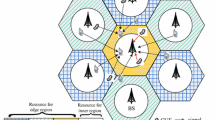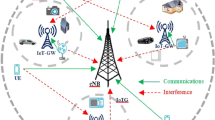Abstract
In a cellular network (CN), cellular users (CUs) located nearby machine type communications (MTC) devices (MTC-Ds) may act as uplink gateways to relay data to the base station (BS). We consider non-orthogonal multiple access (NOMA) and successive interference cancellation (SIC) at the receiver to increase the number of connected devices and the spectrum efficiency. Both underlay and overlay spectrum access modes (SAMs) are considered. We introduce a dynamic user grouping (UG) concept as a practical constraint for SIC, in order to decrease the receiver complexity. Moreover, SIC constraints are introduced based on a minimum signal-to-noise-plus-interference ratio (SINR) at the receiver. We formulate a joint dynamic UG, power allocation, and resource block (RB) assignment problem, aiming at maximizing the total sum-rate of both CUs and MTC-Ds. We transform the obtained non-convex mixed-integer programming problem into a convex problem by using a quadratic fractional programming (FP). A heuristic method is also proposed to reduce complexity. Simulation results demonstrate that the proposed solution outperforms the conventional CN (C-CN) method and the results of the proposed optimization methods are close to optimal solution obtained by the exhaustive search (ES) algorithm in terms of total average sum-rate and network connectivity, while requiring less transmit power. The heuristic method decrease the computational complexity of the FP method at the expense of a small reduction in spectrum efficiency.





Similar content being viewed by others
References
Cao Y, Jiang T, Han Z (2016) A survey of emerging M2M systems: context, task, and objective. IEEE Internet Things J 3(6):1246–1258. https://doi.org/10.1109/JIOT.2016.2582540
Rigazzi G, Pratas NK, Popovski P, Fantacci R (2015). In: 2015 IEEE international conference on communications (ICC). https://doi.org/10.1109/ICC.2015.7248779. IEEE, pp 2973–2978
3GPP (2016) Evolved universal terrestrial radio access (E-UTRA) and evolved universal terrestrial radio access network (EUTRAN) - overall description. Technical Specification (TS) 36.300, 3rd Generation Partnership Project (3GPP), version V13.2.0
3GPP (2015) Cellular system support for ultra-low complexity and low throughput internet of things (CIoT). Technical Report (TR) 45.820, 3rd Generation Partnership Project (3GPP), version V13.1.0
Nasir AA, Tuan HD, Duong TQ, Debbah M (2019) NOMA throughput and energy efficiency in energy harvesting enabled networks. IEEE Trans Commun. https://doi.org/10.1109/TCOMM.2019.2919558
Nasir AA, Tuan HD, Duong TQ, Poor HV (2019) UAV-enabled communication using NOMA. IEEE Trans Commun. https://doi.org/10.1109/TCOMM.2019.2906622
Do TN, Da Costa DB, Duong TQ, An B (2018) Improving the performance of cell-edge users in NOMA systems using cooperative relaying. IEEE Trans Commun 66(5):1883–1901. https://doi.org/10.1109/TCOMM.2018.2796611
Ali MS, Tabassum H, Hossain E (2016) Dynamic user clustering and power allocation for uplink and downlink non-orthogonal multiple access (NOMA) systems. IEEE Access 4:6325–6343. https://doi.org/10.1109/ACCESS.2016.2604821
Brighente A, Tomasin S (2019) Power allocation for non-orthogonal millimeter wave systems with mixed traffic. IEEE T Wirel Commun 18(1):432–443. https://doi.org/10.1109/TWC.2018.2881090
Shao X, Yang C, Chen D, Zhao N, Yu FR (2018) Dynamic IoT device clustering and energy management with hybrid NOMA systems. IEEE T Ind Inform 14(10):4622–4630
Nguyen V-D, Tuan HD, Duong TQ, Poor HV, Shin O-S (2017) Precoder design for signal superposition in MIMO-NOMA multicell networks. IEEE J Sel Areas Commun 35(12):2681–2695. https://doi.org/10.1109/JSAC.2017.2726007
Kazeminia M, Mehrjoo M, Tomasin S (2019) Delay-aware spectrum sharing solutions for mixed cellular and D2D links. ComCom 139:58–66. https://doi.org/10.1016/j.comcom.2019.03.011
Pan Y, Pan C, Yang Z, Chen M (2018) Resource allocation for D2D communications underlaying a NOMA-based cellular network. IEEE Wireless Commun Le 7(1):130–133. https://doi.org/10.1109/LWC.2017.2759114
Kazmi SA, Tran NH, Ho TM, Manzoor A, Niyato D, Hong CS (2018) Coordinated device-to-device communication with non-orthogonal multiple access in future wireless cellular networks. IEEE Access 6:39860–39875. https://doi.org/10.1109/ACCESS.2018.2850924
Madani N, Sodagari S (2018) Performance analysis of non-orthogonal multiple access with underlaid device-to-device communications. IEEE Access 6:39820–39826. https://doi.org/10.1109/ACCESS.2018.2855753
Li J, Huang S (2017) Delay-aware power control for D2D communication with successive interference cancellation and hybrid energy source. IEEE Wireless Commun Le 6(6):806–809. https://doi.org/10.1109/LWC.2017.2744625
Zhao J, Liu Y, Chai KK, Chen Y, Elkashlan M (2017) Joint subchannel and power allocation for NOMA enhanced D2D communications. IEEE Trans Commun 65(11):5081–5094. https://doi.org/10.1109/TCOMM.2017.2741941
Yoon T, Nguyen TH, Nguyen XT, Yoo D, Jang B, et al. (2018) Resource allocation for NOMA-based D2D systems coexisting with cellular networks. IEEE Access 6:66293–66304. https://doi.org/10.1109/ACCESS.2018.2876354
Kazeminia M, Tomasin S, Mehrjoo M (2018) Resource allocation for uplink NOMA and D2D links with MLWDF scheduling discipline. In: 2018 IEEE 29th annual international symposium on personal, indoor and mobile radio communications (PIMRC). https://doi.org/10.1109/PIMRC.2018.8580750, pp 1–6
Yang Z, Xu W, Pan Y, Pan C, Chen M (2018) Energy efficient resource allocation in machine-to-machine communications with multiple access and energy harvesting for iot. IEEE Internet Things J 5(1):229–245
Shen K, Yu W (2018) Fractional programming for communication systems—part I: Power control and beamforming. IEEE Trans Signal Process 66(10):2616–2630. https://doi.org/10.1109/TSP.2018.2812733
Bertsekas DP (2014) Constrained optimization and lagrange multiplier methods. Academic Press, New York
Acknowledgments
The authors would like to acknowledge the Ministry of Science, Research and Technology (MSRT) of Islamic Republic of Iran and the University of Sistan and Baluchestan, as well as the University of Padova, Italy with a scholarship by Fondazione Gini for funding this research.
Author information
Authors and Affiliations
Corresponding author
Additional information
Publisher’s Note
Springer Nature remains neutral with regard to jurisdictional claims in published maps and institutional affiliations.
Rights and permissions
About this article
Cite this article
Kazeminia, M., Mehrjoo, M. & Tomasin, S. A D2D-Based Solution for MTC Connectivity Problem in NOMA-Based Cellular IoT Networks: Dynamic User Grouping and Resource Allocation. Mobile Netw Appl 25, 1998–2011 (2020). https://doi.org/10.1007/s11036-020-01546-y
Published:
Issue Date:
DOI: https://doi.org/10.1007/s11036-020-01546-y




